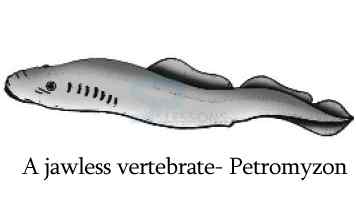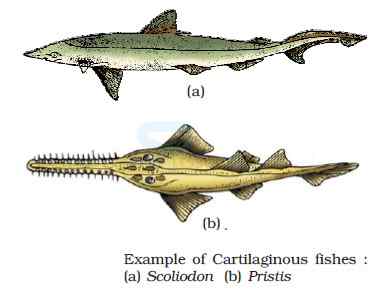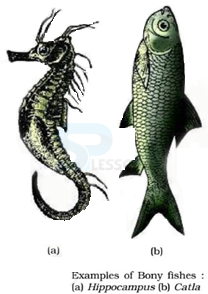 Introduction
Introduction
Q. How is the Animal Kingdom Classified?
Ans: Animal Kingdom is classified into
Class - Cyclostomata
Class - Pisces
Class - Amphibia
Class - Reptilia
Class - Aves
Class - Mammalia
 Types
Types
- All living members of the class Cyclostomata are ectoparasites [ives on the outside of its host] on some fishes.
- They have an elongated body bearing 6-15 pairs of gill slits for respiration.
- Cyclostomes have a sucking and circular mouth without jaws.
- Their body is devoid of scales and paired fins.
- Cranium and vertebral column are cartilaginous.
- Circulation is of closed type.
- Cyclostomes are marine but migrate for spawning [release or deposit eggs] to fresh water.
- After spawning, within a few days, they die. Their larvae, after metamorphosis [transformation from an immature form to an adult form in two or more distinct stages. Example: Larvae → Tadpole → Frog], return to the ocean.
- Examples: Petromyzon (Lamprey) and Myxine (Hagfish).
Image: Jawless vertebrate - Petromyzon
Source: NCERT Text Books
- These are fish. Their skin is covered with scales/plates. They lay eggs [oviporous].
- They obtain oxygen dissolved in water by using gills.
- The body is streamlined, and a muscular tail is used for movement.
- They are cold-blooded and their hearts have only two chambers, unlike the four that humans have.
- Some fish skeletons are made entirely of cartilage [Chondrichthyes], such as sharks, and some with a skeleton made of both bone and cartilage [Osteichthyes].
Image: Examples of Cartilaginious Fishes
Source: NCERT Text Books
- They are marine animals with streamlined body and have cartilaginous endoskeleton. Mouth is located ventrally.
- Notochord is persistent throughout life.
- Gill slits are separate and without operculum (gill cover).
- The skin is tough, containing minute placoid scales.
- Teeth are modified placoid scales which are backwardly directed.
- Their jaws are very powerful.
- These animals are predaceous [shark].
- Due to the absence of air bladder, they have to swim constantly to avoid sinking.
- Heart is two-chambered (one auricle and one ventricle).
- Some of them have electric organs (e.g., Torpedo) and some possess poison sting (e.g., Trygon).
- They are cold-blooded (poikilothermous) animals, i.e., they lack the capacity to regulate their body temperature.
- Sexes are separate. In males pelvic fins bear claspers.
- They have internal fertilisation and many of them are viviparous [give birth to young ones].
- Examples: Scoliodon (Dogfish), Pristis (Sawfish), Carchaiodon (Great white shark), Trygon (Stingray).
- It includes both marine and fresh water fishes with bony endoskeleton.
- Their body is streamlined. Mouth is mostly terminal.
- They have four pairs of gills which are covered by an operculum on each side.
- Skin is covered with cycloid/ctenoid scales.
- Air bladder is present which regulates buoyancy.
- Heart is two- chambered (one auricle and one ventricle).
- They are cold-blooded
- Sexes are separate.
- Fertilisation is usually external.
- They are mostly oviparous and development is direct.
- Examples: Flying fish, Seahorse, Fighting fish, Angel fish etc.
Image: Examples of Bony Fishes
Source: NCERT Text Books
- As the name indicates (Gr., Amphi : dual, bios, life), amphibians can live in aquatic as well as terrestrial habitats.
- The amphibian skin is moist without scales [mucus glands in the skin]. The eyes have eyelids. A tympanum represents the ear.
- Alimentary canal, urinary and reproductive tracts open into a common chamber called cloaca which opens to the exterior.
- They have a three-chambered heart (two auricles and one ventricle). These are cold-blooded
- Respiration is through gills, lungs and through
- Respiration is by gills, lungs and through skin.
- Sexes are separate. Fertilisation is external.
- They are oviparous and development is indirect.
- Examples: (Toad, Frog), Tree frog, Salamander, Limbless amphibia.
- The class name refers to their creeping or crawling mode of locomotion (Latin, repere or reptum, to creep or crawl).
- They are mostly terrestrial animals and their body is covered by dry and cornified skin, epidermal scales or scutes. Snakes and lizards shed their scales as skin cast.
- They do not have external ear openings. Tympanum represents ear. Limbs, when present, are two pairs.
- Heart is usually three-chambered, but four-chambered in crocodiles.
- Reptiles are poikilotherms [cold-blooded animals].
- They lay eggs with tough coverings and do not need to lay their eggs in water, unlike amphibians.
- Sexes are separate.
- Fertilisation is internal.
- They are oviparous and development is direct.
- Examples: Turtle), Tortoise, Chameleon (Tree lizard), Garden lizard, Crocodile, Alligator, Wall lizard, Poisonous snakes - Naja (Cobra), Bangarus (Krait), Vipera (Viper).
- They have a four-chambered heart. They breathe through lungs. All birds fall in this category.
- The characteristic features of Aves (birds) are the presence of feathers and most of them can fly except flightless birds (e.g., Ostrich). The forelimbs are modified into wings.
- The hind limbs generally have scales and are modified for walking, swimming or clasping the tree branches.
- Skin is dry without glands except the oil gland at the base of the tail.
- Endoskeleton is fully ossified (bony) and the long bones are hollow with air cavities (pneumatic).
- The digestive tract of birds has additional chambers, the crop and gizzard.
- They are warm-blooded (homoiothermous) animals, i.e., they are able to maintain a constant body temperature.
- Respiration is by lungs. Air sacs connected to lungs supplement respiration.
- Sexes are separate. Fertilisation is internal. They are oviparous and development is direct.
- Examples: Crow, Pigeon, Ostrich), Neophron (Vulture) etc..
- Mammals are warm-blooded animals with four-chambered hearts.
- Most mammals familiar to us produce live young ones. However, a few of them, like the Platypus and the Echidna lay eggs, and some, like kangaroos give birth to very poorly developed young ones.
- They are found in a variety of habitats - polar ice caps, deserts, mountains, forests, grasslands and dark caves. Some of them have adapted to fly or live in water.
- The most unique mammalian characteristic is the presence of milk producing glands (mammary glands) by which the young ones are nourished.
- They have two pairs of limbs, adapted for walking, running, climbing, burrowing, swimming or flying.
- The skin of mammals is unique in possessing hair. External ears or pinnae are present. Different types of teeth are present in the jaw.
- Heart is four-chambered. They are homoiothermous [warm-blooded]. Respiration is by lungs.
- Sexes are separate and fertilisation is internal.
- They are viviparous with few exceptions and development is direct.
- Examples: Oviparous – Platypus; Viviparous – Kangaroo, Flying fox), Delphinus (Common dolphin), Balaenoptera (Blue whale), etc.








